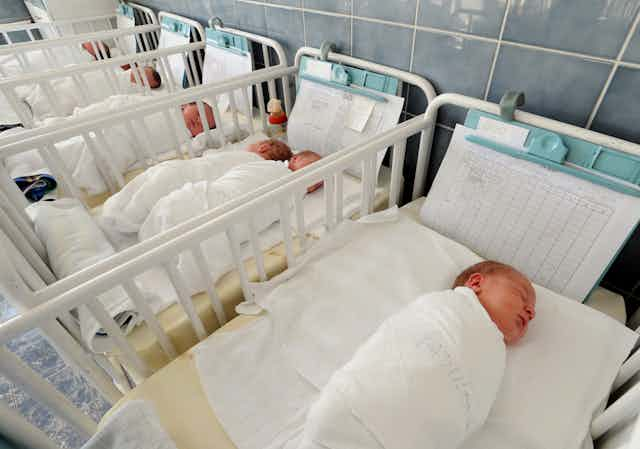The birth rate in England and Wales is now the lowest it has ever been since records began. Only 11 babies were born for every 1,000 people in 2018, with 657,076 born overall. To put this in perspective, 957,782 babies were born in 1920 despite the overall population being 22m fewer than it is today.
It may not seem a cause for concern. We are all familiar with the strain being placed on the environment by increased human activity – and in fact it has even been suggested that to help tackle climate change people should be having fewer children.
But with an increasingly ageing population, and Brexit due to impact on the number of non-British workers in the employment market, the UK is facing a population crisis.
All time low
This isn’t the first time the UK has encountered such an issue. The early 20th century saw a continued decline in birth rates combined with high levels of infant mortality. And with the losses of the First World War and the threat of another conflict approaching, motherhood was increasingly of interest to both society and state.
Concern over the sustained reduction in birth rates prompted increased levels of government involvement in maternal and child welfare. The Maternity and Child Welfare Act of 1918 extended the powers of local authorities to establish antenatal clinics, educational classes, dental treatment and home visits for expectant mothers, and empowered them to provide food and milk for pregnant women in need.

At a time when state aid was uncommon, pregnant women and infants were unusually favoured. By 1921, £9.8m a year was spent on community care and £7.7m on maternal and child welfare. By 1937, community care expenditure totalled £29.5m – with £17.4m alone spent on maternal and child welfare services.
Over time, a package of measures was put in place to attempt to support mothers and ensure the health of both mothers and children. And the number of infant welfare centres in England and Wales increased massively – from 650 in 1915 to 3,580 by 1938.

As the century progressed, the country continued to invest in its families. In 1945, the Family Allowances Act was passed, paying five shillings a week for each child in a family – excluding the eldest if one adult was in work. The rate was increased in 1952 by a further three shillings, and in 1956 the Family Allowances Act extended the payments to all children.
Alongside efforts to financially support families, there were various government funded projects that attempted to uncover the root causes of birth rate decline. In 1937, a survey titled “The Reluctant Stork” was undertaken to ask a sample of women why they were not expanding their families. The answers that came back broadly fell into the categories of money, lack of support, housing and security.
An ageing nation
In times of uncertainty, families do not add to their number – this is as true now as it was in the 1930s. And the decline in birthrate in the UK is as serious a matter in 2019 as it was a century ago.
The UK is an increasingly aged nation and that is only set to become more so. There are 26.6m people in the UK aged between 40 and 79 – these are the people who, in the next 20 years, will be needing care or approaching that point. In contrast, there are fewer than 14m young people under the age of 19 – the people who in the next 20 years will be providing that care.
Right now there is a deficit of 100,000 staff across the NHS – with a further 110,000 vacancies in adult social care. That is the situation with an EU workforce still supporting the system – 62,000 of NHS England’s 1.2m workers and approximately 104,000 of the 1.3m employees within adult social care are EU nationals.
So given that the birth rate has fallen consistently for over 60 years, it’s clear there will not be enough young people coming into the workforce. And with an ageing population, the strain upon that smaller number is all the greater.
Families hit hardest
The UK is unsettled and the future is uncertain. Austerity has been in force for almost a decade and the impact has been felt by many families. Whereas the interwar and post-1948 governments made mothers and children a priority in order to tackle the low birth rate, the last ten years has seen support for families rolled back.
Sure Start centres have been closed in their hundreds, a two child limit has been enforced on Tax Credit and Universal Credit payments, maternity services are struggling and infant mortality rates are rising.
This is a national crisis once more and one that can only be tackled by again placing social and financial value on parenting and the family. The UK needs children. It needs children to support the economy and the ageing population in the decades ahead. But the only way this will happen is if children and families are valued and supported once more.

